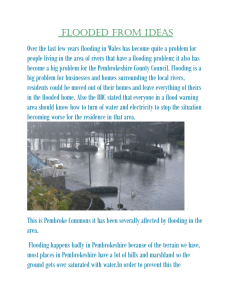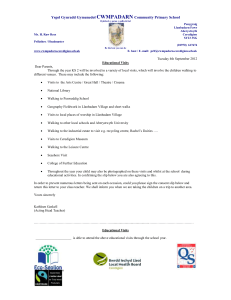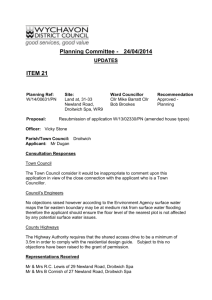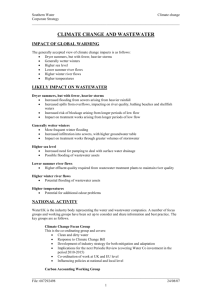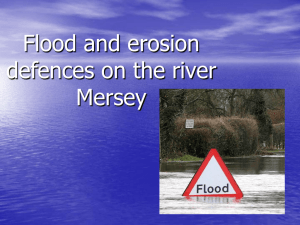File
advertisement
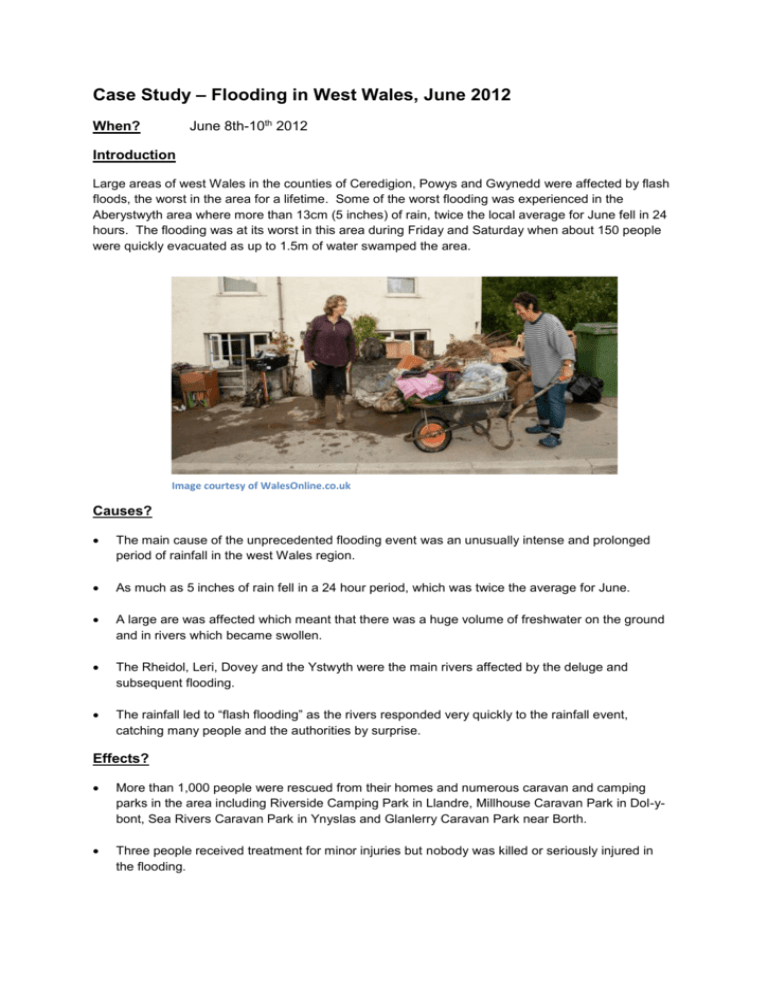
Case Study – Flooding in West Wales, June 2012 June 8th-10th 2012 When? Introduction Large areas of west Wales in the counties of Ceredigion, Powys and Gwynedd were affected by flash floods, the worst in the area for a lifetime. Some of the worst flooding was experienced in the Aberystwyth area where more than 13cm (5 inches) of rain, twice the local average for June fell in 24 hours. The flooding was at its worst in this area during Friday and Saturday when about 150 people were quickly evacuated as up to 1.5m of water swamped the area. Image courtesy of WalesOnline.co.uk Causes? The main cause of the unprecedented flooding event was an unusually intense and prolonged period of rainfall in the west Wales region. As much as 5 inches of rain fell in a 24 hour period, which was twice the average for June. A large are was affected which meant that there was a huge volume of freshwater on the ground and in rivers which became swollen. The Rheidol, Leri, Dovey and the Ystwyth were the main rivers affected by the deluge and subsequent flooding. The rainfall led to “flash flooding” as the rivers responded very quickly to the rainfall event, catching many people and the authorities by surprise. Effects? More than 1,000 people were rescued from their homes and numerous caravan and camping parks in the area including Riverside Camping Park in Llandre, Millhouse Caravan Park in Dol-ybont, Sea Rivers Caravan Park in Ynyslas and Glanlerry Caravan Park near Borth. Three people received treatment for minor injuries but nobody was killed or seriously injured in the flooding. Evacuation of Aberystwyth Holiday Village where more than 150 people were removed for their own safety. Dozens of homes, businesses, cars and other interests were devastated by the floodwaters which destroyed the contents of people’s homes and left thick mud and possible contamination in their wake. Sewers damaged in the flooding led to fears of a potential biohazard and harmful contaminants. A lifeboat crew who were attempting to rescue holidaymakers were airlifted to safety themselves after their vessel was swept away by the torrent. Some gas and water supplies were damaged. The cost of repairs and returning these communities to normal is huge, possibly up to £10 million with the average individual insurance claim between £20,000 and £40,000. The local area is a key tourist destination and Ceredigion alone attracts 640,000 overnight trips per year, worth £115 million per year to the local economy. The Aberystwyth and Ceredigion County Show was cancelled which was due to be held on Saturday, June 9th. The psychological and emotional effects of the flooding and the pure shock of the events that unfolded was a major factor in the following days, weeks and months. On Sunday 10th June the village of Pennal near Machynlleth in Powys was evacuated effecting more than 600 people after there were fears that a local reservoir had developed a leak after a landslide. A structural engineer was flown in to survey the damage and residents were moved to the local leisure centre. It was deemed safe to return following a controlled release of water into the river to release the pressure on the dam. Response? The reponse was rapid with local emergency services, Ceredigion County Council and members of the community being rallied to help in a difficult situation. The Environment Agency did put out an advance warning that made a difference to the people in the area and no doubt saved numerous lives. The RAF and RNLI were both involved in what was a widespread and challenging series of events and were praised for their fantastic efforts in rescue and evacuation by the Prime Minister David Cameron. The first minister of Wales Carwyn Jones praised the emergency services and noted that the professionalism and dedication of all those who were involved in the rescue operations was the reason no lives were lost. The local community and the council rallied, supporting those who were displaced from homes and holiday accommodation by providing beds and places to stay. An emergency fund was launched by Ceredigion County Council to help the people worst affected by the flooding to return to normality and salvage what they could. John Griffiths, the Welsh Government Environment minister assured that Ceredigion Council would also be eligible to apply to the Emergency Financial Assistance Scheme which provides money to local authorities who have had to deal with expensive, major emergencies in their areas. Future events? It was noted by a number of councillors, ministers and Environment Agency personnel that there were important lessons to be learnt from the flooding and although this was “probably” a once in a lifetime event for these communities, similar events of this magnitude should not be ruled out. The Environment Agency stated that this was a “once in a 100 year rainfall event”. Monitoring of rivers was to be reviewed and also land development planning in flood risk areas was in need of an overhaul. In the current climate it was said that no-one is safe from flooding and everything that can be done to prevent future events should be put in place. Chris Mills from the Environment Agency said that it should be accepted that flooding will happen and the most important thing is to manage the risk. Sources: The Daily Telegraph newspaper The Guardian newspaper http://www.walesonline.co.uk/news/wales-news/2012/06/12/unknown-91466-31160364/ http://www.itv.com/news/wales/2012-06-11/communities-rally-to-restore-homes-after-flood-damage/ http://www.walesonline.co.uk/news/wales-news/2012/06/13/flooding-latest-insurance-premiumscould-soar-91466-31174076/ Further information on the floods can be found on these web pages above which include a couple of useful video interviews.


